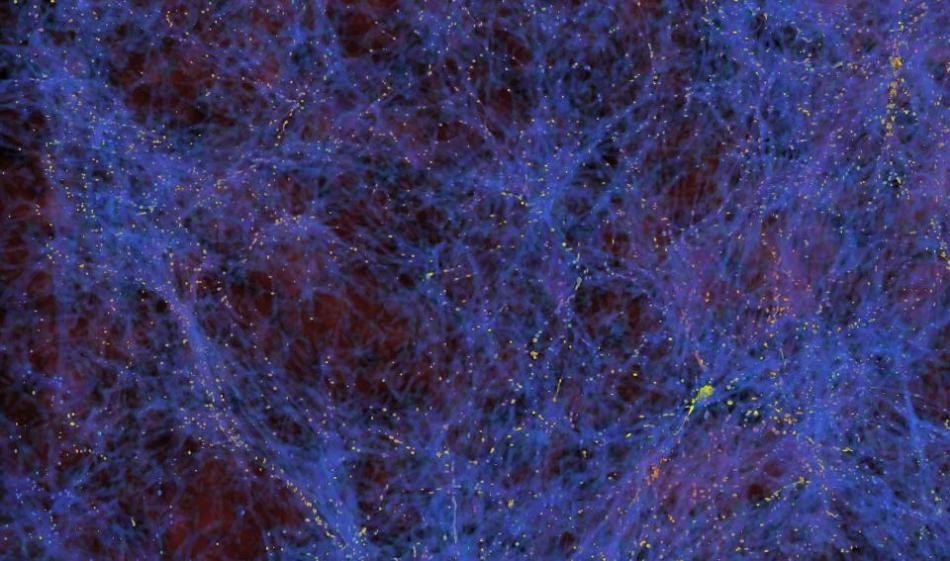Jun 11 2019
Two theoretical physicists from the University of California, Davis, have come up with a new candidate for dark matter, as well as a probable method for detecting it. They presented their study at the Planck 2019 conference in Granada, Spain, on June 6th, 2019. The study has been submitted for publication.
 A simulation of the large-scale structure of the universe with filaments of dark matter in blue and places of galaxy formation in yellow. Dark matter cannot yet be detected directly. UC Davis physicists have proposed a new model to explain it. (Image credit: Zarija Lukic/Lawrence Berkeley National Laboratory)
A simulation of the large-scale structure of the universe with filaments of dark matter in blue and places of galaxy formation in yellow. Dark matter cannot yet be detected directly. UC Davis physicists have proposed a new model to explain it. (Image credit: Zarija Lukic/Lawrence Berkeley National Laboratory)
It is considered that dark matter constitutes slightly more than one-quarter of the universe. A major part of the remaining is even more mysterious dark energy. Although it cannot be viewed directly, the existence of dark matter can be detected since its gravity governs the shape of distant galaxies and other objects.
According to a number of physicists, dark matter is composed of some particle that has not been discovered yet. For some time, the candidate of choice has been the weakly interacting massive particle (WIMP). However, even after several years of effort, WIMPs have not appeared in experiments developed to detect them.
We still don’t know what dark matter is. The primary candidate for a long time was the WIMP, but it looks like that’s almost completely ruled out.
John Terning, Professor of Physics, UC Davis
Terning is the co-author of the study.
A substitute to the WIMP model of dark matter advocates a form of “dark electromagnetism” including “dark photons” and other particles. Dark photons would have a specific level of weak coupling with “regular” photons.
In the new study, Terning and postdoctoral researcher Christopher Verhaaren add a twist to this concept—a dark magnetic “monopole” that would interact with the dark photon.
In the macroscopic realm, there are always two poles for magnets—north and south. A monopole is a particle acting similar to one end of a magnet. Although the existence of monopoles has been proposed by quantum theory, they have never been observed in an experiment. The researchers propose that dark monopoles would interact with dark electrons and dark photons in the same manner that theory predicts photons and electrons interact with monopoles.
Moreover, this suggests a method for the detection of these dark particles. According to the physicist Paul Dirac, an electron that moves in a circle close to a monopole would pick up a change of phase in its wave function. Since electrons occur as both waves and particles according to quantum theory, the same electron could pass on either side of the monopole and consequently be somewhat out of phase on the other side.
This interference pattern, known as the Aharonov-Bohm effect, suggests that an electron that passes around a magnetic field is influenced by it, although it does not pass through the field itself.
According to Terning and Verhaaren, a dark monopole can be detected due to the way it shifts the electrons’ phase as they pass by.
“This is a new type of dark matter but it comes with a new way to look for it as well,” stated Terning.
It is comparatively easy to observe electron beams: In the 1960s, the Aharonov-Bohm effect was demonstrated by using electron microscopes, and electron beam technology has advanced with time, stated Terning.
In theory, particles of dark matter stream through us constantly. According to Terning and Verhaaren’s model, for the monopoles to be detectable, they would have to be excited by the sun. Then, they would take nearly a month’s time to reach Earth, traveling at about one-thousandth of the speed of light.
By contrast, the estimated phase shift is considerably small—smaller than what is required to detect gravity waves, for instance. However, according to Terning, when the LIGO gravity wave experiment was first put forward, the technology that could make it functional did not exist—rather, technology caught up over time.
The study was supported by a grant from the U.S. Department of Energy.